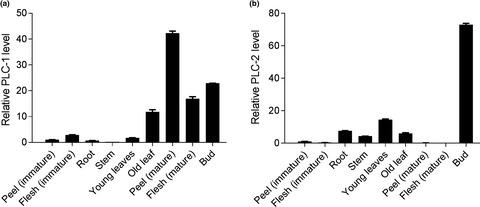当前位置:
X-MOL 学术
›
Food Sci. Nutr.
›
论文详情
Our official English website, www.x-mol.net, welcomes your
feedback! (Note: you will need to create a separate account there.)
Role of phospholipase C in banana in response to anthracnose infection
Food Science & Nutrition ( IF 3.5 ) Pub Date : 2020-01-10 , DOI: 10.1002/fsn3.1388 Liang Shuai 1, 2, 3 , Li Li 3, 4 , Jian Sun 1, 3, 4 , Lingyan Liao 2 , Zhenhua Duan 2 , Changbao Li 3, 4 , Xuemei He 3, 4
Food Science & Nutrition ( IF 3.5 ) Pub Date : 2020-01-10 , DOI: 10.1002/fsn3.1388 Liang Shuai 1, 2, 3 , Li Li 3, 4 , Jian Sun 1, 3, 4 , Lingyan Liao 2 , Zhenhua Duan 2 , Changbao Li 3, 4 , Xuemei He 3, 4
Affiliation

|
Phospholipase C (PLC) plays an important role in plant immunity, and anthracnose caused by the Colletotrichum species is a common postharvest disease of the banana fruit. This study aims to evaluate the role of PLC in anthrax resistance in banana. The experimental group of banana samples was treated with a banana anthracnose conidia suspension, and the control group was treated with distilled water. After inoculation, the groups were sprayed with ethephon, and indicators, such as hardness and conductivity changes; PLC activity, 1,2‐diacylglycerol (DAG) and phosphatidic acid (PA)content; and MaPLC‐1and MaPLC‐2 expression levels, were assessed at 0, 3, 6, 9, 12, and 15 days. Moreover, the expression levels of MaPLC‐1 and MaPLC‐2 were detected in various tissues. The hardness of banana fruits in the experimental group decreased faster than that in the control group. Furthermore, the conductivity was higher in the experimental group than in the control group. Regarding PLC activity, DAG, and PA content, bananas in the experimental group showed higher activities than those in the control group. Moreover, relatively higher expression of PLC mRNA was detected in anthracnose‐inoculated tissues. The evaluation of MaPLC‐1 and MaPLC‐2 expression levels showed that the mature peel had the highest MaPLC‐1 expression level. However, the MaPLC‐2 gene was expressed at relatively low levels in the fruit and at relatively high levels in the flower organs. PLC might play a role in fruit ripening in response to anthracnose resistance.
中文翻译:

香蕉中磷脂酶 C 在应对炭疽病感染中的作用
磷脂酶C(PLC)在植物免疫中发挥着重要作用,由炭疽菌引起的炭疽病是香蕉果实常见的采后病害。本研究旨在评估 PLC 在香蕉抗炭疽病中的作用。实验组香蕉样品用香蕉炭疽病分生孢子悬浮液处理,对照组用蒸馏水处理。接种后各组喷洒乙烯利,硬度、电导率等指标发生变化; PLC活性、1,2-二酰基甘油(DAG)和磷脂酸(PA)含量;在第 0、3、6、9、12 和 15 天评估MaPLC-1和MaPLC-2表达水平。此外,在多种组织中检测到MaPLC-1和MaPLC-2的表达水平。实验组香蕉果实硬度下降速度快于对照组。此外,实验组的电导率高于对照组。在PLC活性、DAG和PA含量方面,实验组香蕉的活性高于对照组。此外,在接种炭疽病的组织中检测到 PLC mRNA 的表达相对较高。 MaPLC-1和MaPLC-2表达水平的评估表明,成熟果皮的MaPLC-1表达水平最高。然而, MaPLC-2基因在果实中的表达水平相对较低,而在花器官中的表达水平相对较高。 PLC 可能在果实成熟中发挥作用,以应对炭疽病抗性。
更新日期:2020-01-10
中文翻译:

香蕉中磷脂酶 C 在应对炭疽病感染中的作用
磷脂酶C(PLC)在植物免疫中发挥着重要作用,由炭疽菌引起的炭疽病是香蕉果实常见的采后病害。本研究旨在评估 PLC 在香蕉抗炭疽病中的作用。实验组香蕉样品用香蕉炭疽病分生孢子悬浮液处理,对照组用蒸馏水处理。接种后各组喷洒乙烯利,硬度、电导率等指标发生变化; PLC活性、1,2-二酰基甘油(DAG)和磷脂酸(PA)含量;在第 0、3、6、9、12 和 15 天评估MaPLC-1和MaPLC-2表达水平。此外,在多种组织中检测到MaPLC-1和MaPLC-2的表达水平。实验组香蕉果实硬度下降速度快于对照组。此外,实验组的电导率高于对照组。在PLC活性、DAG和PA含量方面,实验组香蕉的活性高于对照组。此外,在接种炭疽病的组织中检测到 PLC mRNA 的表达相对较高。 MaPLC-1和MaPLC-2表达水平的评估表明,成熟果皮的MaPLC-1表达水平最高。然而, MaPLC-2基因在果实中的表达水平相对较低,而在花器官中的表达水平相对较高。 PLC 可能在果实成熟中发挥作用,以应对炭疽病抗性。











































 京公网安备 11010802027423号
京公网安备 11010802027423号